Discover 20 hidden attractions, cool sights, and unusual things to do in Santa Cruz de Tenerife (Spain). Don't miss out on these must-see attractions: Auditorio de Tenerife, Iglesia de la Concepción, and Parque García Sanabria. Also, be sure to include Castillo de San Cristóbal in your itinerary.
Below, you can find the list of the most amazing places you should visit in Santa Cruz de Tenerife (Canary Islands).
Table of Contents
Auditorio de Tenerife

Arts venue in iconic wavelike structure. The Auditorio de Tenerife "Adán Martín" is an auditorium in Santa Cruz de Tenerife, Canary Islands, Spain. Designed by architect Santiago Calatrava, it is located on the Avenue of the Constitution in the Canarian capital, and next to the Atlantic Ocean in the southern part of Port of Santa Cruz de Tenerife. Construction began in 1997 and was completed in 2003. The auditorium was inaugurated on 26 September of that year in the presence of Felipe, Prince of Asturias, and was later visited by former U.S. President Bill Clinton. The building is framed within the tenets of late-modern architecture of the late 20th century.
The majestic profile of the auditorium has become an architectural symbol of the city of Santa Cruz de Tenerife, the island of Tenerife and the Canary Islands. It is also regarded as the finest contemporary building in the Canary Islands and one of the most emblematic buildings of Spanish architecture. In March 2008, it was included by the post office in a set of six stamps (Correos) depicting the most emblematic works of Spanish architecture. In 2011, the image of the Tenerife Auditorium was included in a series of commemorative coins of 5 euros, which displayed the most emblematic symbols of several Spanish cities. It is one of the major attractions of Tenerife and home to the Orquesta Sinfónica de Tenerife (Tenerife Symphony Orchestra).[1]
Address: Av de la Constitucion, 1, 38003 Santa Cruz de Tenerife
Iglesia de la Concepción
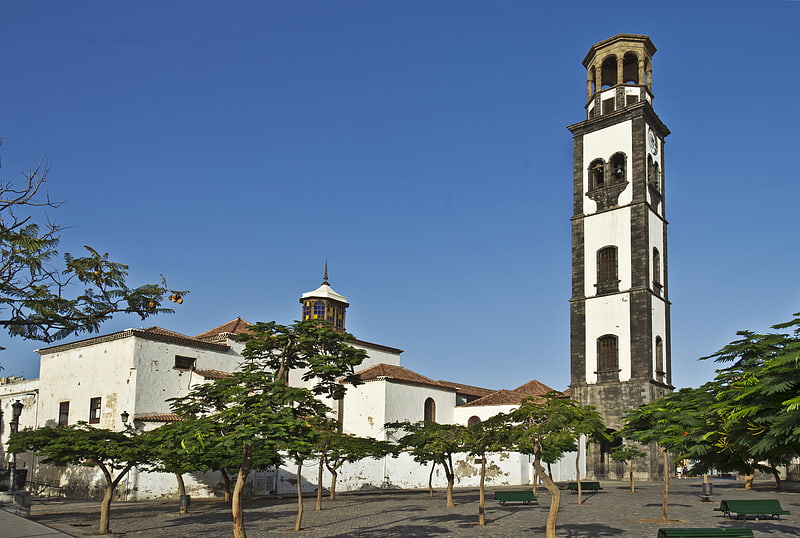
Also known as: Iglesia Matriz de la Concepción
Catholic church in Santa Cruz, Spain. The Iglesia-Parroquia Matriz de Nuestra Señora de La Concepción is a Catholic church located in the city of Santa Cruz de Tenerife. It is the only church in the Canary Islands that has five naves.
This church was built upon the first chapel erected by the Spanish conquistadors after landing on the coast where they would later build the city. This church is the main temple of the city, which is why it is called "the Cathedral of Santa Cruz". However, it not is a cathedral; the Cathedral of La Laguna is the cathedral of Tenerife.
In 1500 work began to build a church dedicated to the Holy Cross founded by Father Juan Guerra. It was one of the first churches built on the island of Tenerife. Specifically, the Church of the Conception of Santa Cruz was built near the place where the first Christian mass observed on the island of Tenerife after the founding of the city of Santa Cruz de Tenerife was held.
The Iglesia de la Concepción is dedicated to the Immaculate Conception of the Virgin Mary. In this church is the image of St. James (patron saint of Santa Cruz de Tenerife). Inside the church is kept the cross that gave rise to the founding of the city. Stresses the organ, brought from London and acquired in 1862. In this church is a relic of St. Clement I, Pope and Martyr, donated by the Patriarch of Antioch, Mr. Sidotti. Historically this was highly revered relic in the city.
In the temple there is a small Gothic image of the fifteenth century of the Our Lady of Consolation (historical patron saint of Santa Cruz de Tenerife), of historical merit, it was the same as the Alonso Fernández de Lugo placed in the hermitage of that name. It was the first Virgin that venerated in Santa Cruz and one of the first devotions of Tenerife.
The architectural style of the church is baroque and Tuscan. The bell tower is the most identifiable part of the church. The Church of the Conception has been declared a site of cultural interest.[2]
Address: C/ Antonio Domínguez Alfonso (LA NORIA) 4, junto a la Iglesia de la Concepción, Santa Cruz de Tenerife
Parque García Sanabria
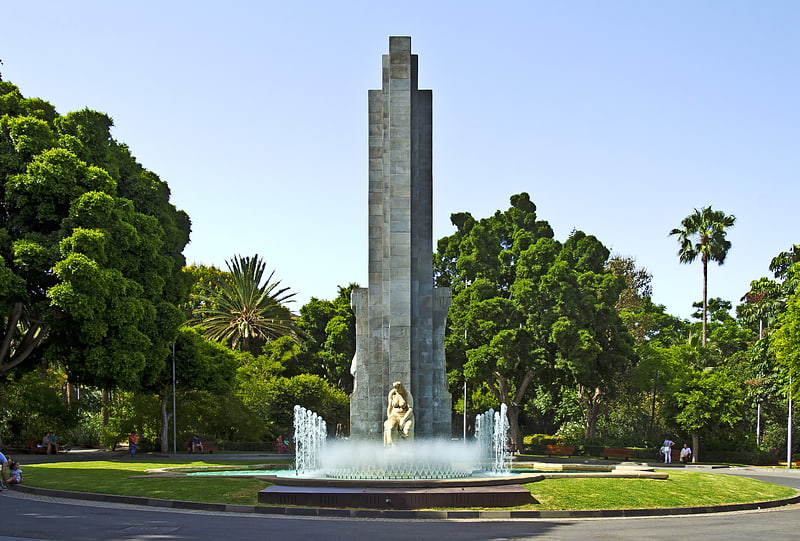
Park in Santa Cruz, Spain. Parque García Sanabria is a public urban park in the heart of Santa Cruz de Tenerife in Tenerife. It was inaugurated in 1926. It is a large garden area, combined with fountains and architectural groups. The park is listed as a site of cultural interest by the Government of the Canary Islands.
Its name derives from the Mayor Garcia Sanabria, who approved its construction. It is the largest urban park in the Canary Islands. It has an area of 67,230 square metres (723,700 sq ft). In 1973 an international sculptural exposition took place there. Some of the sculptures, thirteen or so, were displayed on that occasion to adorn all corners and walks in the park.[3]
Address: Rambla de Santa Cruz, 95, 38004 Santa Cruz de Tenerife
Castillo de San Cristóbal
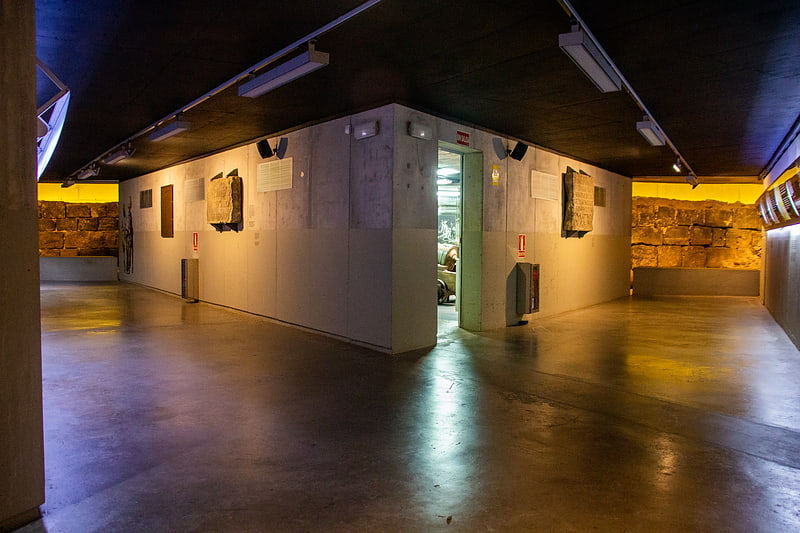
Museum in Santa Cruz, Spain. The Castle of San Cristóbal in Santa Cruz de Tenerife was the first fortification of significance on the island of Tenerife and the main defensive building on Santa Cruz Bay. The central Castle Street is named after this fort.
Under the administration of Gov. Álvarez de Fonseca, construction began in 1575 but it was the January 20, 1577 when it entered service. The castle was demolished to construct the Plaza de España, with the remains of the castle buried under it for centuries. On June 28, 2006, during the refurbishment of the Plaza of Spain, some remains were later found to belong to the castle. At that time precautionary and protective measures were taken in order to ensure the preservation of the find.
There remain only a few walls of the original building on display in a tunnel under the Plaza de España. Today, the castle is a museum which houses the famous "Cañón Tigre" (Tiger Cannon), which shot a musketball to Rear-Admiral Horatio Nelson's right arm, which fractured his humerus bone in multiple places on July 25, 1797, the reason why he had his arm amputated.[4]
Castillo de San Juan
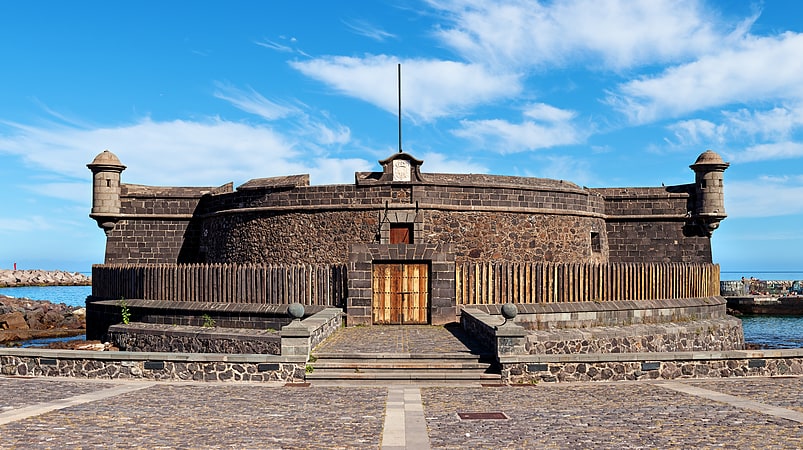
Tourist attraction in Santa Cruz, Spain. The Castle of St John the Baptist, also called the Black Castle, is a fort on the island of Tenerife in the Canary Islands of Spain. It was the second-most important fort in the defence of Santa Cruz de Tenerife, the island's capital.
It is located in the heart of the capital near the Parque Marítimo César Manrique and behind the Auditorio de Tenerife. Its construction was started in 1641 and completed in 1644. It was later rebuilt in 1765 with the addition of a cylindrical tower facing the sea. It served as a military fort until 1924. It was converted to a military museum in 1948.
In 1684, Charles II of Spain gave the power to appoint the castilian, or warden of the castle, to the Cabildo de Tenerife, the island's governing body. This appointment, along with that of the Castle of San Cristóbal, were coveted by the island's nobility as an honour, but also for two important reasons: it was the most important way to prove their noble status, with a view to entering orders, joining the military or the maestranza de caballería (noble militia), and due to the privileges attached to the position: they were in charge of everything related to health, the port police, granting permits for the entry and exit of the ships, they charged the right to fish, they mediated between the conflicts between fishermen and townsfolk, besides taking care of correspondence and collecting tariffs on salt and flour.
A re-enactment of the Battle of Santa Cruz de Tenerife takes place annually at the fort, in commemoration of the unsuccessful attempt by the British admiral Horatio Nelson to invade the city and the archipelago on 25 July 1797.[5]
Address: Av de la Constitución, 1, 38003 Santa Cruz de Tenerife
Museo de la Naturaleza y el Hombre
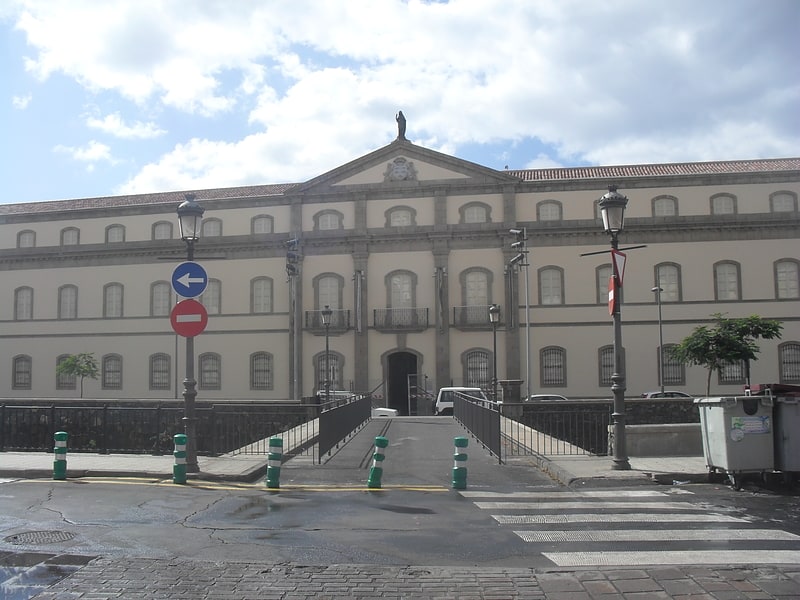
Museum of natural history and archaeology. Museo de la Naturaleza y Arqueología, is a museum-based in Santa Cruz de Tenerife, Tenerife,. It contains many significant archaeological finds and is considered the best repository of objects from the Pre-Castilian Canary Islands. The museum also houses significant paleontological, botanical, entomological, and marine and terrestrial vertebrate collections, and is considered the best Natural Library of the Canary Islands.
Museo de la Naturaleza y el Hombre integrates the Archaeological Museum of Tenerife, the Bioantropología's Canary Institute and the Museum of Natural Sciences of Tenerife. The museum is located in the downtown area of Santa Cruz, in the former Civil Hospital, a building that constitutes an example of the neoclassical architecture of Canary Islands. The archaeological section was founded in 1958.
The museum holds the largest collection on the culture of the Guanche and also has one of the most modern methods of presentation of mummies, (announced in 2006 by the Cabildo de Tenerife through a communique). It is also an internationally renowned museum and has participated in international meetings on archeology, but its fame is mainly due to its formidable collection of Guanche mummies. It is also regarded as the most important museum of Macaronesia.[6]
Address: Calle Fuente Morales, s/n, 38003 Santa Cruz de Tenerife
Plaza de España

Iconic city square with historic remains. Plaza de España, is the largest square in the city of Santa Cruz de Tenerife and the Canary Islands. The square is located in the centre of town, 1.4 km north of the Auditorio de Tenerife. This square is considered one of the "main squares" of the island of Tenerife, together with the Plaza del Cristo de La Laguna in San Cristóbal de La Laguna and the Plaza de la Patrona de Canarias in Candelaria. It hosts an artificial lake fountain, a work of Swiss architects Herzog & de Meuron.
The square was built in 1929 on the historic Castillo de San Cristóbal, a bastion for defending the island of piracy, currently there are only a few walls of the original building on display in a tunnel under the square. Recently the square was refurbished by the Swiss architects Herzog & de Meuron. The Plaza de España is surrounded by the Palacio Insular de Tenerife, the Palacio de la Carta and the Plaza de la Candelaria. In the centre of the square stands Monumento a los Caídos.[7]
Playa de Almáciga
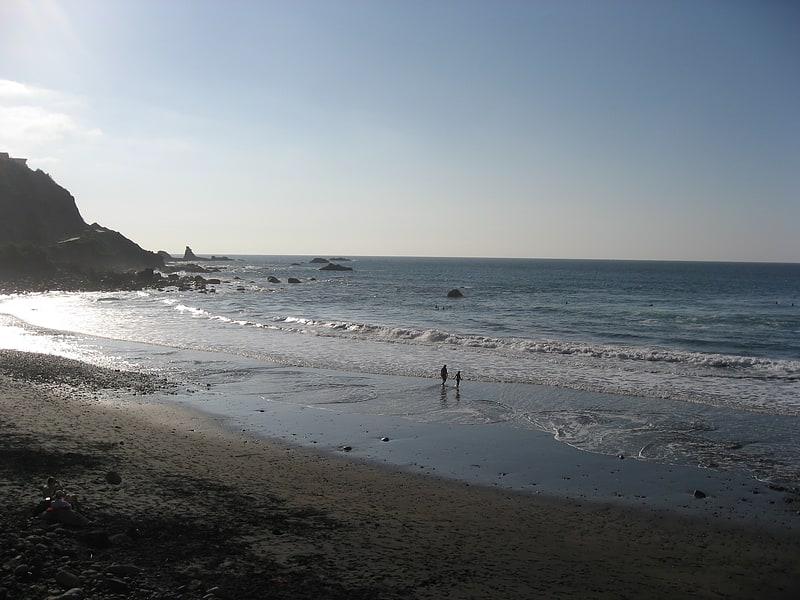
Almáciga beach is located under the hamlet that gives it its name in the district of Anaga in Santa Cruz de Tenerife. With fine sand and a dark color of volcanic origin, Almáciga beach is characterized by its strong waves, which makes it attractive for surfing.
Address: Playa de Almaciga, 38129 Santa Cruz de Tenerife
Barranco Grande Windmill

The Barranco Grande Windmill or Grand Canyon Mill is located in Barranco Grande, Santa Cruz de Tenerife, on the island of Tenerife, Spain. It is similar to the Cuevas Blancas Windmill, and is one of three remaining windmills in the region, the other being in El Rosario, Tenerife.
The mill was conical, with masonry walls, and is around 9 metres (30 ft) high. It was mostly demolished by a mechanical shovel on 27 January 1973. It was listed as Bien de Interés Cultural on 18 December 2007.
The remains were acquired by the Santa Cruz town hall in 2007, who subsequently contracted its restoration to Volconsa at a cost of €425,000. The mill was not completely reconstructed, but the blades and gears were recreated in 2010, and former parts of the windmill are now arranged around the remains.[8]
General Serrador Bridge
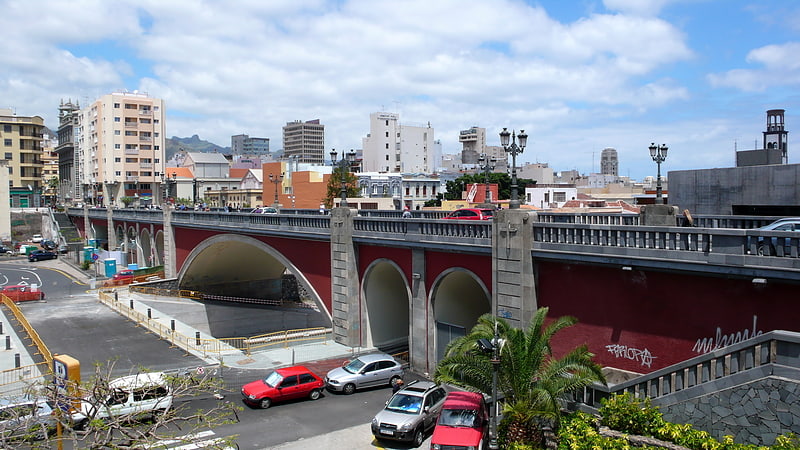
General Serrador Bridge is a bridge across the Barranco de Santos in Santa Cruz de Tenerife, Tenerife, Spain.[9]
Tenerife Espacio de las Artes
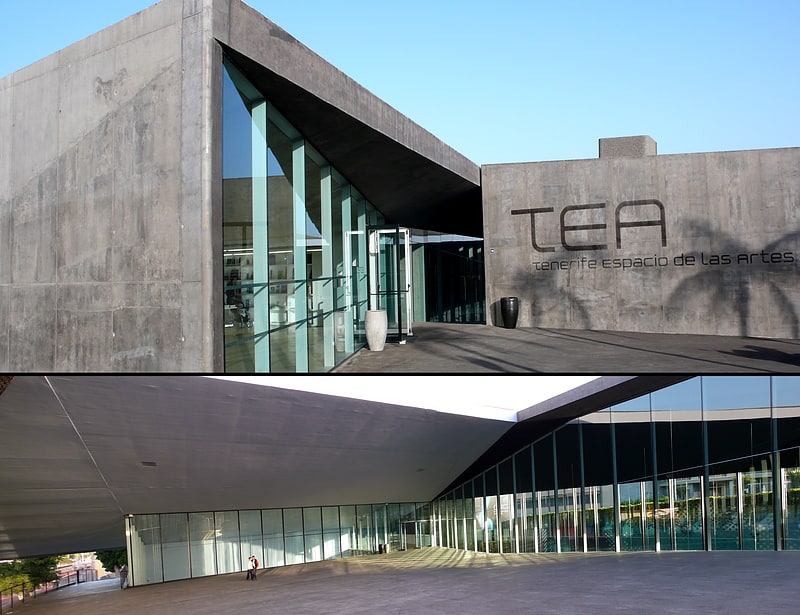
Museum in Santa Cruz, Spain. The Tenerife Arts Space is a cultural space and building in Santa Cruz de Tenerife, Tenerife, Spain. Opened in 2008, it was designed by Herzog & de Meuron and Virgilio Gutierrez. It houses a permanent exhibition of the works of Óscar Domínguez, as well as the Biblioteca Municipal de Santa Cruz de Tenerife, and the Centro de Fotografía Isla de Tenerife. It is operated by the Cabildo de Tenerife.[10]
Address: Avenida San Sebastian No 8, 38003 Santa Cruz de Tenerife
San Joaquin Castle

Castle in Santa Cruz, Spain. San Joaquin Castle is an inland fortification in La Cuesta, on the road that connects Santa Cruz de Tenerife and San Cristóbal de La Laguna, in Tenerife, Canary Islands, Spain.
In 1586, Governor D. Juan Núñez de la Fuente ordered the construction of several platforms at the site, designed by the Italian Leonardo Torriani, which were subsequently abandoned. The current building's construction started in 1780. It was constructed to defend the interior of the island, should the coastal defenses of the island fall.
The castle is square, with circular towers at each corner. It has a central courtyard, with bays on two sides. Two of the towers were used to store gunpowder.
While the outside of the structure has remained constant, the inside has been frequently modified to suit the various uses of the building, varying from a military prison to an ammunitions dump to a dovecote. It was home to the Cuerpo de Colombofilia Militar Español.
It was sold in 1996 to a private individual, and is currently abandoned.
It was recorded by the Spanish Ministry of National Education on 22 April 1949, and it was declared of cultural interest on 15 February 2000.[11]
Palmetum

Botanical garden dedicated to palm trees. The Palmetum of Santa Cruz de Tenerife is a botanical garden of 120.000 m² specialized in palms. It is an artificial hill, with views of the ocean, located in Santa Cruz de Tenerife, Canary Islands, Spain. The gardens include a large system of waterfalls, streams and ponds, a museum dedicated to palms, and a display shade house. The project was started in 1995 on a former landfill and only opened to the public in 2014. The valuable palm collection gathers about 600 species of palms and it is focused on the ones native to world islands. Trees and shrubs of other plant families are also displayed, organised in "biogeographical sections". All gardens are maintained with no pesticides and no fertilizers, different species of wild birds are easily seen in the palmetum.[12]
Address: Avenida Constitucion 5, 38003 Santa Cruz de Tenerife
Museo Municipal de Bellas Artes de Santa Cruz de Tenerife
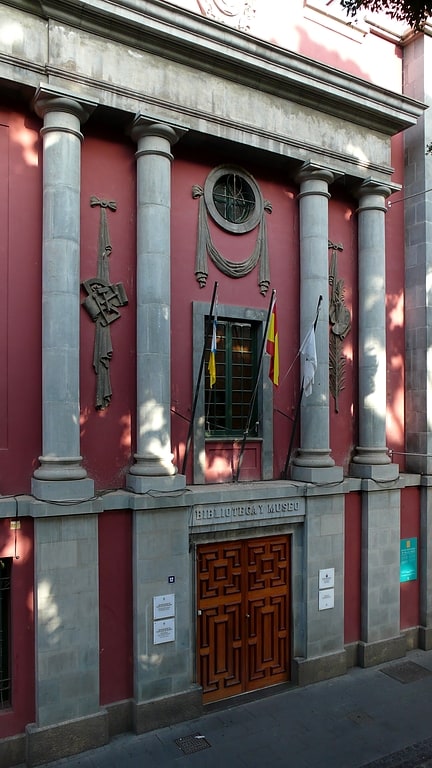
Also known as: Museo municipal de Bellas Artes
Museum in Santa Cruz. The Museo Municipal de Bellas Artes de Santa Cruz de Tenerife is a museum of fine arts located in the city of Santa Cruz de Tenerife. Its headquarters are located in the rear of the Church of St. Francis of Assisi.
The museum dates back to 1840, when the city agreed to make some boxes to preserve flags from the French Revolutionary Wars. The building is of a classical style and was established in early 1929 by the architect Eladio Laredo. The exterior is decorated with ten different busts of the illustrious of Tenerife.
The museum has fourteen rooms that have a background as a repository of works from the Prado Museum in Madrid. The museum houses an art collection ranging from sixteenth-century Flemish to twentieth-century paintings, as well as a sample of sculptures and crafts. The "Tríptico de Nava y Grimón" by the Flemish painter Pieter Coecke is one of the most notable parts of the collection. Other noteworthy works are those by Canarian painter Juan de Miranda, Afonso Gaspar de Quevedo, Jose Rivera and Cristóbal Hernández de Quintana, among others.[13]
Address: José Murphy, 12, 38002 Santa Cruz de Tenerife
Centro Internacional de Ferias y Congresos de Tenerife
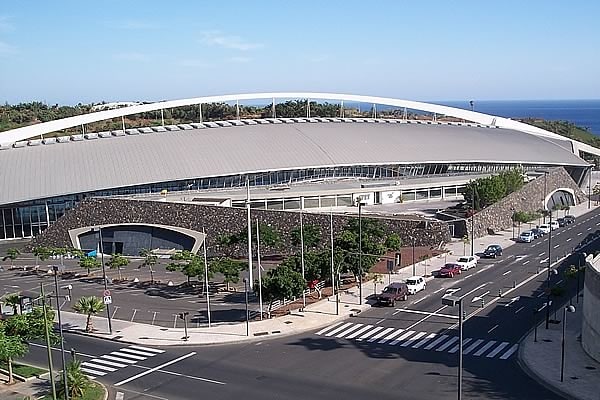
Fairground in Santa Cruz, Spain. The Tenerife International Centre for Trade Fairs and Congresses, also known as "The Fair Recint" was opened in May 1996. The building, covers an area exceeding 40,000 square meters in the sea front of Santa Cruz de Tenerife. Is in close proximity to other venues such as the Parque Marítimo César Manrique, the Auditorio de Tenerife and the Palmetum. The Great Hall, located on the top floor, took a total of 12,000 square meters, making it the largest covered space in the Canary Islands. This building is also the headquarters of the World Trade Center Tenerife.
The complex was designed by architect and engineer Santiago Calatrava is configured as a multipurpose building that can host major fairs, exhibitions and conferences that take place on the island of Tenerife. After its opening in it have developed all kinds of events: trade shows (food, computers, agriculture, recreation, etc.), Music concerts, contests and gala carnival, congresses, seminars, art exhibitions, TV shows, fashion, and a multitude of activities.[14]
Teatro Guimerá
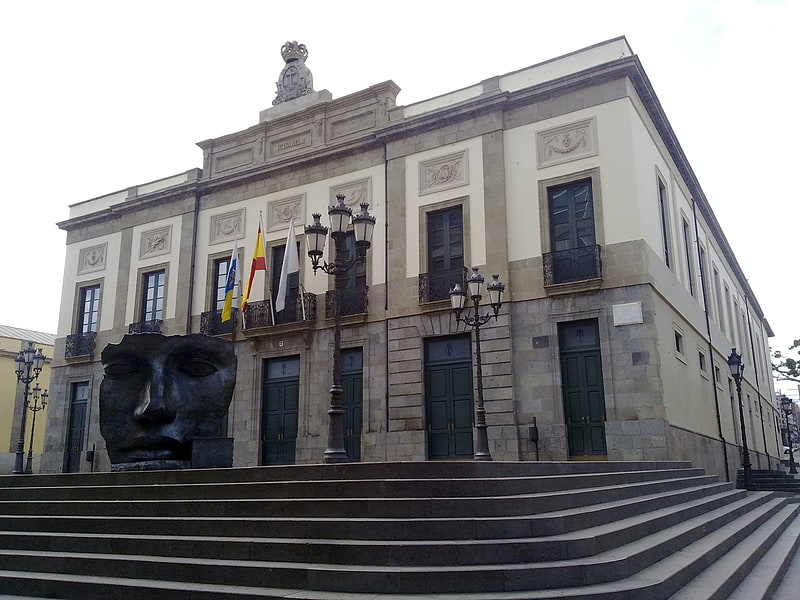
Theatre in Santa Cruz, Spain. Teatro Guimerá is a theatre located in Santa Cruz de Tenerife, the capital city of the island of Tenerife in the Canary Islands. Built in 1849, it is the oldest theater in the Canary Islands. In 1923 it was named after the writer, poet and playwright Ángel Guimerá, born in Santa Cruz de Tenerife.[15]
Address: C/Imeldo Seris, 38003 Santa Cruz de Tenerife
Monument to Franco
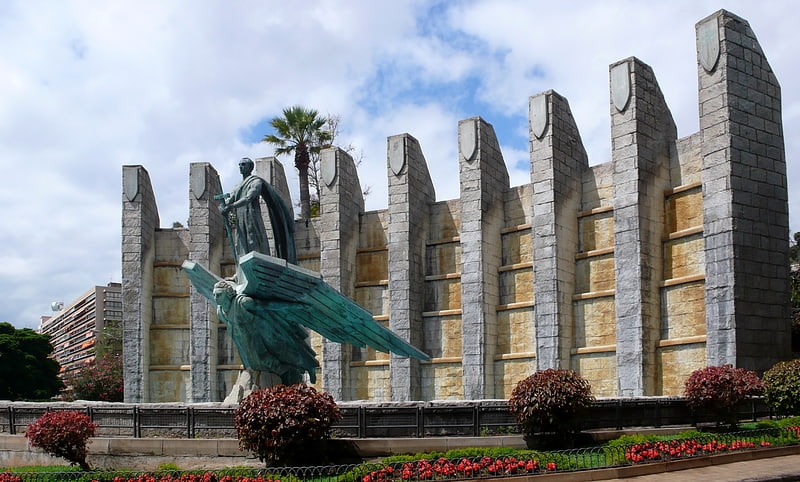
Ángel de la Victoria or the Monument to Victory, popularly known as el monumento a Franco, is an instance of public art located in Santa Cruz de Tenerife, Spain. A work by Juan de Ávalos, the monument was conceived to pay homage to Francisco Franco.[16]
Los Campitos Reservoir
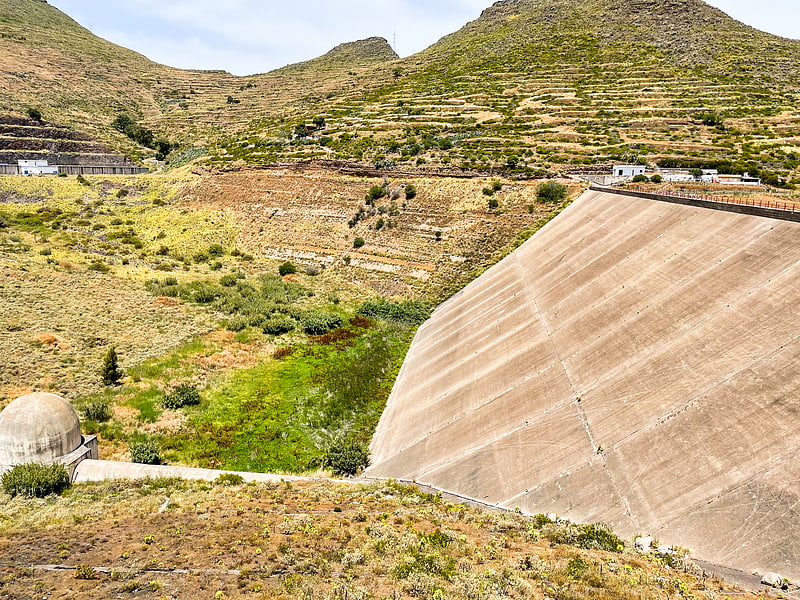
Los Campitos Reservoir is located in the Anchieta ravine, near Los Campitos, above Santa Cruz de Tenerife, in the Canary Islands. The dam was constructed in the 1970s, after which it was discovered that the basin could not hold water. It was subsequently waterproofed in 1978, but has never held water. It was remodeled in the early 2000s, with an enclosed tank and a new pipeline constructed. A study has been conducted to build a hydroelectric plant at the reservoir.[17]
Señor de las Tribulaciones

The Señor de las Tribulaciones is the name given to an image of Jesus Christ that is venerated in the Iglesia de San Francisco de Asís in the city of Santa Cruz de Tenerife.
This is a sculpture of cloth glued an "Ecce Homo" in the 17th century. The image is considered miraculous, is credited with saving the city of Santa Cruz de Tenerife during a cholera epidemic in 1893. The chronicles relate that the image was carried in procession through the streets of the city and the epidemic was eradicated miraculously. For this reason, the Señor de las Tribulaciones is invoked as protector of the city and has been given the title of Señor de Santa Cruz (Lord of Santa Cruz).
Even before this miracle, the miraculous image was already regarded as almost a century earlier, in 1795, the Señor de las Tribulaciones saved from a terrible disease to the wife of an influential man in the city, also began to sweat image miraculously. Currently, the image is carried in procession every Holy Tuesday through the streets of the city to where the epidemic ceased. The sculpture back out in procession on Good Friday.[18]
Parque de La Granja
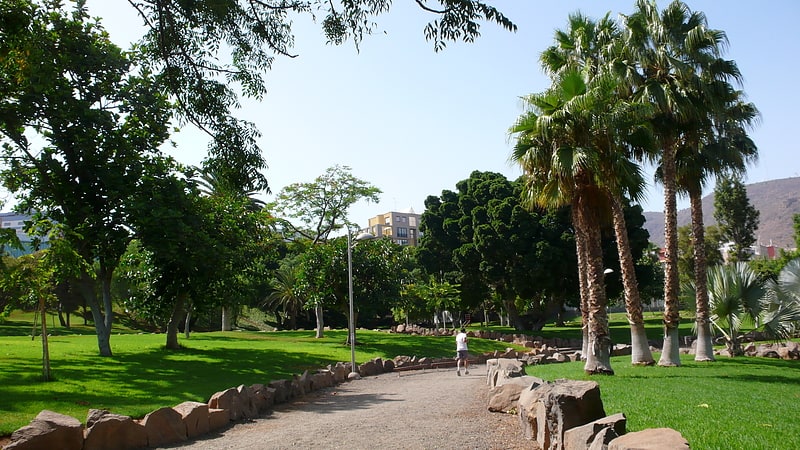
Park in Santa Cruz, Spain. The Parque de La Granja is a park in Santa Cruz de Tenerife, Canary Islands, Spain. It was built between 1969 and 1976. Is a wide area designated for sports, games, rides to admire the flora and more. It is one of the largest urban parks in the Canary Islands.
The Parque de La Granja has a very broad extension of facilities for outdoor sports. It has wide roads of asphalt and gravel, surrounded by garden plots.[19]
Address: Av de Madrid, 38007 Santa Cruz de Tenerife